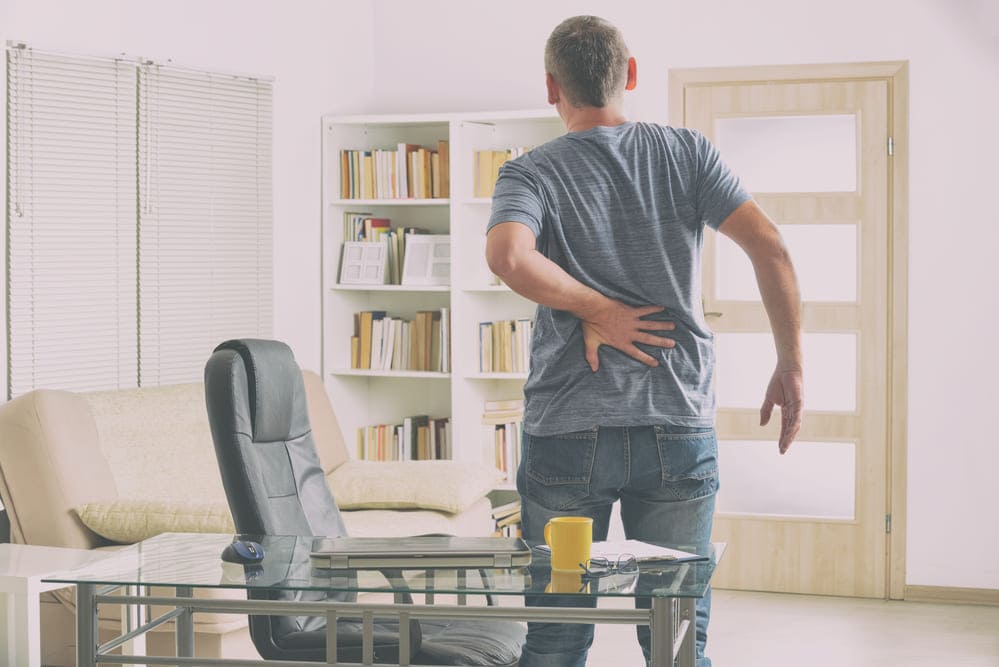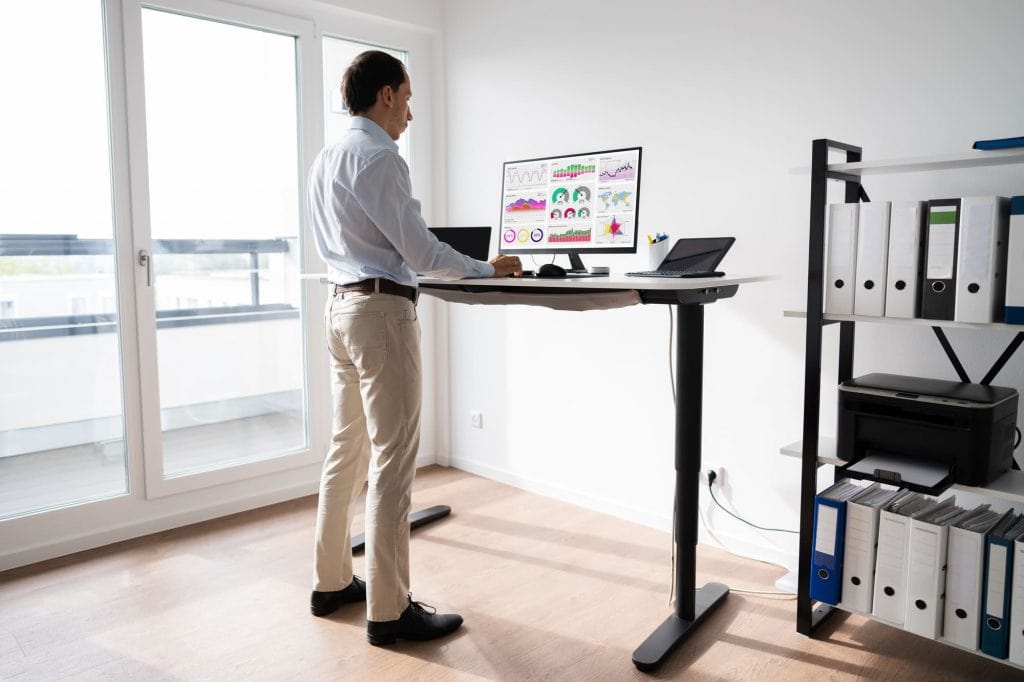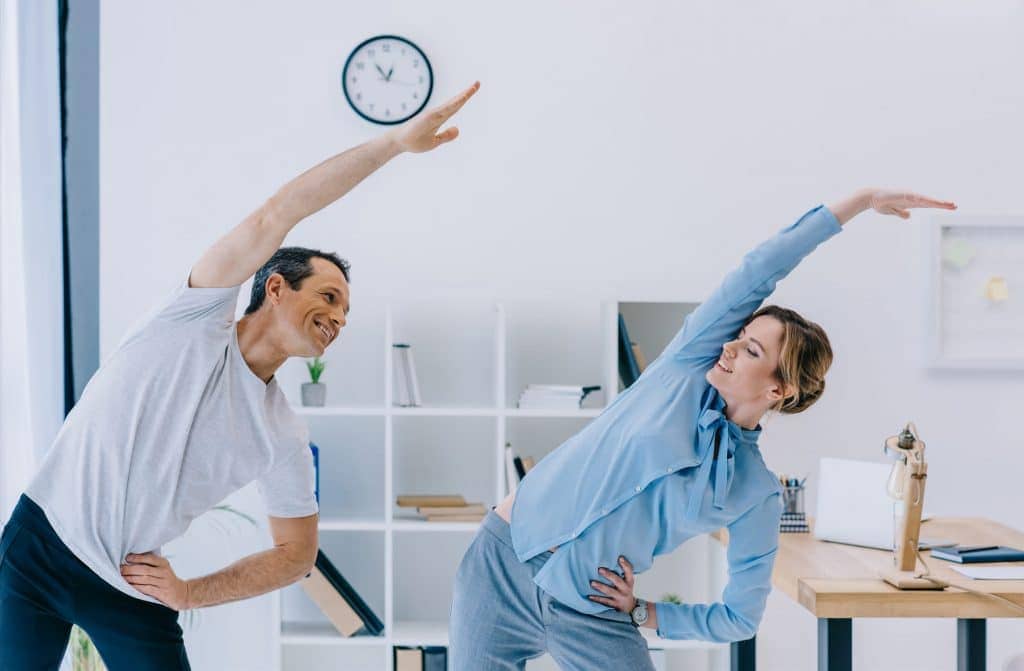*When you buy through links on our site, we may earn an affiliate commission at no additional cost to you.
Ever heard the phrase “Sitting is the new smoking?” That’s another way of saying that the amount of time you spend sitting down every day at your office desk exposes your body to health risks similar to those of smoking.
If you spend hours—say 8 to 10 hours of a workday each day—sitting in your office chair, you are sure to be a “heavy smoker!” Not just in your office, sitting in front of your TV or behind the wheel also adds to your sedentary behavior and the health consequences.
Unknown to many, sedentary behaviour is linked to serious health problems, including excess body fat, cardiovascular diseases, type 2 diabetes, various cancers, and premature death.
Extended periods of sitting also restrict blood flow and circulation and can hurt your neck, shoulder, and back. Studies have also linked too much sitting to Alzheimer’s disease, deep vein thrombosis, and increased stress levels.
This guide delves into more details about why sitting is the new smoking. We will discuss in more detail how excessively sitting hurts your health, how to reduce your sedentary habits, and other important information you need to know about the sitting disease.
Table of Contents
Is sitting the new smoking?
Dr. James Levine, the Professor of Medicine at the Mayo Clinic, is credited with coining the phrase sitting is the new smoking during an interview with LA Times.
He said,
“Sitting is more dangerous than smoking, kills more people than HIV, and is more treacherous than parachuting. We are sitting ourselves to death.” He adds, “The chair is out to kill us.”
The Professor of Medicine estimates that most Americans spend most of their hours seated at their desk jobs, watching television, or driving.

But how true are the claims?
Going by this 2014 report by the Centers for Disease Control and Prevention, smoking has a similar chronic disease list as sitting for long hours. These smoking-attributable diseases include diabetes, cancer, and cardiovascular disease.
Remember that smoking is one of the past century’s greatest public health disasters.
Researchers found that while sitting increases death risk by 25%, smoking ups it by a whopping 180%!
Also, secondhand smoke exposure is connected to a disproportionately high risk of stroke. It has even been linked to as many as 2.5 million deaths in the U.S alone.
While sitting and smoking may have similar effects on your body health, smoking may be an even bigger monster. And comparing the two can be somehow misleading.
Nonetheless, both habits will cause serious harm to your body!
Why too much sitting is bad for your health?
We human beings are designed to stand upright. Your heart and cardiovascular system will work more efficiently when you’re standing.
Your bowel will also work more efficiently when you’re standing upright. This is a good explanation of why bedridden people in the hospital usually experience issues with their bowel function.
When you’re moving and stay physically active, your overall endurance and energy expenditure improve compared to when you’re seated. And your bones become stronger.
Dig deeper into the topic of excessive sitting, and you’ll discover that Dr. Levine is not the only one who believes sitting puts your body’s health at risk.
Various researches seem to support his claims and the need to spend less time sitting. However, not all studies agree that sitting is the new smoking, which is quite understandable.
Too much sitting: What the researchers say
Dr. Joan Vernikos, the author of “Sitting Kills, Moving Heals” and a former director of the NASA Life Sciences Division, seems to support that sitting is an unhealthy habit. She explains that we weren’t designed to sit. And your body is meant to be a perpetual motion machine.
While exercising is good for you, don’t trust it to reverse the damage caused to your health due to sedentary behavior.
Katy Bowman, a scientist, and author of the “Move Your DNA: Restore Your Health Through Natural Movement,” told Reuters, “You can’t offset 10 hours of stillness with one hour of exercise.”
You might wonder why this suggestion…the truth is that marathon sitting significantly impacts your body’s metabolism.
This is clearly explained by Gavin Bradley, the Director of Active Working (an international organization whose main aim is to combat extended hours of sitting).
According to him, metabolism in your body slows down by 90% after just 30 minutes of sitting. The enzyme tasked with moving bad body fat from the arteries to your muscles to be burned off slows down.
The muscles in your lower body get turned off too. In just 2 hours (ie, time spent sitting), your body cholesterol levels drop to 20%.
He suggests that if you could just get up for 5 minutes, you’d get things running smoothly again in your body.
Toni Yancey, the professor of health services at UCLA’s Fielding School of Public Health, also has this to say about the same process:
“Sitting shuts down electrical activity in the legs. It makes the body less sensitive to insulin, causes calorie-burning to plummet, and slows the breakdown of dangerous blood fats, lowering ‘good’ HDL cholesterol.”
Engaging your body in moderate-intensity physical activity could help
Other researchers analyzed 13 studies related to sitting time and activity levels. They discovered that test subjects who spent more than eight hours sitting daily without engaging in any physical activity had a death risk similar to that caused by obesity and smoking.
This analysis involving data from over 1 million people also concluded that folks who engage in moderate-intensity physical activity for 65 to 70 minutes daily could easily counter the effects of extended periods of sitting.
What are the health risks of too much sitting?
Long sitting hours can have detrimental effects on your body’s health and wellbeing. It exposes your body to serious health risks, including obesity, type 2 diabetes, cancer, and cardiovascular diseases (including stroke and heart attack).
Also, too much sitting can restrict blood circulation and flow and encourage bone strength and muscle tone loss.
Gravity and fatigue will take over when you sit for extended periods of time, leading to rounded shoulders and a slumped back posture.
These will cause neck and lower back pain, shoulder spurs/impingement syndrome, painful trigger points, and potential disc degeneration.
Let’s get into more specific details on the health risks of too much sitting.
Obesity
One of the dangers of excessive sitting is weight gain and obesity. When you move your muscles, your body is able to digest the sugars and fats you eat.
Spending a lot of time sitting makes your digestion less efficient, meaning you retain those unwanted body fat and sugars in your body.
Dr. Levine kicked off his research by looking into the dangers of prolonged hours of sitting and the benefits offered by standing desks. He was trying to understand why some individuals tend to gain weight while others do not.

For this study, he placed officer workers that didn’t exercise on a 1,000-calorie diet and had them not change their excise routine. The result is some of them gained weight while others lost weight.
The participants in the study were then required to wear underwear with a sensor at the waist. The sensor aimed to help him determine how much each of them was moving per day.
And he discovered the missing link—the group that registered weight loss was moving more (2.25 hours more hours a day) than the group that added weight.
Standing helps you burn up to 50 calories more per hour. If you stand 3 hours every day for five days every week, that’s 75-0 calories burned. This is a total of 30,000 calories annually (approximately 9 pounds). This is the equivalent of 10 marathons in a year.
This explains why Dr. Levine greatly advocates using standing desks to reduce the effects of prolonged periods of sitting.
Cardiovascular disease
Cardiovascular disease is another common health issue in folks who sit for long hours. Various studies seem to confirm that sitting indeed endangers your heart health.
The London bus drivers study:
One such study was done in 1953 and involved London bus drivers. In this study, the British researchers compared the heart disease rates of London bus drivers who sat vs. the standing bus conductors.
They found that the drivers who sat for the entire day registered more heart attacks and other heart-related issues than their counterparts who stood.

Dr. James Levine, who is behind the “sitting is the new smoking” phrase, cited a study comparing adults who watch TV more than 4 hours a day with those who spend less than 2 hours a day in front of the TV or any other screen.
The study suggests that adults with a greater screen or television viewing time had a 50% higher risk of death from any cause. This group also registered a 125% increased risk of events linked to cardiovascular disease, including angina (chest pain) and heart attack.
Even when the amount of physical activity (or exercise) was controlled, the researchers still concluded that the sitters were 34% more likely to suffer from heart failure than those who were moving or standing.
Another 2010 study by the University of South Carolina’s Arnold School of Public Health also found that men who registered over 23 hours of sedentary lifestyle were at a 64% higher risk of dying from cardiovascular events like heart disease than those who sat for less than 11 hours a week.
Type 2 diabetes
Research also shows that people who spend more time sitting are at a high risk of getting type 2 diabetes. This health risk usually occurs when your body makes no insulin hormone at all.
Though this disease is usually associated with lack of exercise and improper diet, many studies now point out that prolonged periods of sitting also have a hand in it.
For people with diabetes, sitting for long periods can worsen your condition.

One such study published in the National Institute of Health found that extended periods of sitting causes reduced ability to regulate blood glucose in your bloodstream. This condition is known as metabolic syndrome and significantly raises your risk of type 2 diabetes.
The Cancer Prevention Research Centre, based in the University of Queensland in Brisbane, Australia, through a 2008 study, concluded that people who take the most breaks from sitting reported reduced triglyceride count. This is good news, given that a higher triglyceride is associated with an increased risk of diabetes.
Another research focusing on 37 people with type 2 diabetes indicated that prolonged sitting hours for over 2 weeks led to high blood sugar levels. This study also found that when the participants stood up or made walks between sitting periods, they registered lower blood sugar levels.
Cancer
Various studies point out that long periods of sitting can put you at risk of certain types of cancer, including uterine, lung, prostate, breast, and colon cancer.
Christine Friedenreich, Canada’s Alberta Health Services-Cancer Care epidemiologist, estimates that a total of 173,000 cancer cases in the US result from inactivity.
Among these, 49,000 are breast cancer cases, while 43,000 are colon cancer cases. 37,200 are lung cancer cases, 30,600 are prostate cancer cases, 12,000 are endometrial cancer cases, and 1,800 are ovarian cancer cases.
That being said, the underlying mechanism through which long sitting hours causes the various types of cancer is still unclear.
But as research continues, scientists have found several biomarkers like the C-reactive protein at higher levels in individuals who sit for extended hours.
Premature death
Yes, inactivity resulting from sitting for long periods in your office chair can shorten your lifespan.
In fact, physical inactivity contributes to up to 3plus million preventable deaths across the globe each year (which accounts for 6% of all deaths). This makes it the 4th leading cause of deaths caused by non-communicable diseases.
A study carried out in Australia in 2010 showed that for every extra hour the participants spent sitting for a period of 7 years, their mortality rate increased by up to 11%.
Another study conducted in 2012 suggests that if the average American reduces their sitting time to 3 hours every day, their life expectancy will go up by 2 years.
Researchers in Australia also found that adults who spent more than 11 hours a day sitting had a 40% increased risk of mortality in the next 3 years compared to adults who sat for not more than 4 hours every day. Keep in mind that this research considered the participants’ health and exercise levels.
The American Cancer Society conducted the effects of prolonged sitting and early death. They found that participants who spent 6plus hours a day sitting had a 37% raised risk of premature death compared to those who sat for less than 3 hours.
Male participants in the same study showed a 17% raised risk of death (including those who exercised regularly).
Other health problems connected to prolonged sitting:
Besides the health issues discussed above, too much sitting also restricts blood flow and circulation in your body.
It also causes body aches (whether it’s back, shoulder, back, or legs and glutes pain), which can cause discomfort and affect your focus and productivity at work.
Neck, shoulders, and back pain
Spending long periods of time hunched over your computer keyboard can lead to stiffness and pain in your shoulders and neck.

Extended seat time can also cause back problems, especially if you consistently adopt poor posture when sitting or don’t sit in an ergonomically designed office chair or workspace.
Poor posture can lead to problems with your spine health by causing spine discs’ compression—leading to premature degeneration, which is a painful experience.
Your hips, too, won’t survive long sitting time. They’re unable to support you well when you spend long hours sitting. Prolonged sitting shortens your hip flexor muscles, which ultimately results in hip joint problems.
Researchers at Cornell University Department of Ergonomics found that you exert 90% more pressure on your lower back when sitting compared to when you’re standing.
Loretta DiPietro, the chairman of the Department of Exercise at Milken Institute School of Public Health at George Washington University, has dedicated most of his time to researching the harmful effects of long sitting hours.
After she cut back on the number of hours she sits per day, she noticed weight loss and couldn’t experience shooting pains in her legs anymore.
Overall, if you experience back or neck pain, sit for many hours a day, and don’t sit in the correct posture, then sitting is likely the source of this pain.
Weak leg and glute muscles
Getting glued to your office chair for long hours can also weaken and waste away your large glute and leg muscles.
As you already know, these are your body’s largest group of muscles. They play a crucial role in walking and balancing you. Due to inactivity caused by numerous sitting hours, these muscles become weak.
When this happens, you’re highly likely to injure yourself in case you fall or due to strains caused by attempts to exercise.
Deep vein thrombosis (DVT)
This condition is characterized by blood clots forming in a deep vein in your body when you sit for long hours. Deep vein thrombosis usually occurs in your legs.

And if it breaks loose, it can lead to pulmonary embolism (PE). This is simply the blockage of the lung artery.
PE is risky in that it can damage your lungs permanently, cause low blood oxygen levels, and even damage the organs in your body due to lack of oxygen.
Note that DVT can also occur after you’ve undergone surgery and are bedridden for days. Those who travel on long flights, drive in a car, or sit while working at home are also at the risk of DVT.
Alzheimer’s disease
According to this study published by researchers at UCLA, sitting for extended hours may increase your risk of Alzheimer’s and dementia.
This is undoubtedly bad news for those who value their memories and mind. And who doesn’t?
The study was led by Prabha Siddarth of the UCLA Semel Institute for Neuroscience and Human Behavior. It looked at a group of participants aged between 45 and 75. It involved monitoring the hours they sat each day in the previous week.
The brains of these individuals were then scanned using high-resolution MRI to examine the thickness of their medial temporal lobes (the part of the brain tasked with creating and storing memory).
Needless to say, the results weren’t anything good!
Researchers concluded that those participants who reported longer sitting hours every day had thinner medial temporal lobes. According to the statement released by UCLA, this can become a precursor to dementia and cognitive decline in middle-aged and older adults.
Even worse, the researchers explain that any amount of physical activity (even at high levels) isn’t sufficient to offset the harmful effects to your brain resulting from extended periods of sitting.
Anxiety and depression
Sitting for long hours can also lead to increased stress levels and affect your mental health.
An Australian study published in the Mental Health and Physical Activity journal showed that employees who spent more than 6 hours every day sitting had higher anxiety and depression rates than those who sat for less than 3 hours daily.
Even more, women showed higher psychological distress levels than men who participated in the same study.

Another study also seems to echo the fact that prolonged seat time is connected to anxiety and depression. This study involved 9000 female participants in their 50s and found out that those who spent 7plus hours per day sitting were 3x more likely to develop depression symptoms compared to those who only sat for less than 4 hours daily.
Dr. Megan Teychenne, a physical activity lecturer at Deakin University in Australia, analyzed nine studies, 2 on children and 7 on adults. And she explains that they showed moderate evidence regarding the association between anxiety risk and chair time.
In her own words,
“Anecdotally, we are seeing an increase in anxiety symptoms in our modern society, which seems to parallel the increase in sedentary behavior.”
Other possible causes of anxiety and depression include poor health diet, social isolation, and disturbed sleep caused by spending a lot of time in front of a screen.
How to reduce the amount of time you spend sitting?
There are various ways you can save yourself from the dangers of sedentary behaviour, as explained below.
Be active at work
One of the most effective ways of reducing the time you spend sitting is being more active at work. Some physical activity ideas you can engage in to keep you active throughout your workday and reduce time in your office chair include:
- Takes stairs instead of the elevator whenever possible
- Park your car as far away as possible at work or when running errands to encourage you to walk for longer distances
- Stand up when receiving phone calls or replying to text messages.
- Stand when watching television at home. Use a commercial break as your cue to stand and move around.
- Walk down the hall or to another office when you want to talk to your coworkers instead of calling/texting/emailing them
- Encourage fellow coworkers to walk and talk with you instead of sitting in the conference room during meetings (ie, encourage walking meetings).
Stand and move more at home
Sedentary behavior doesn’t stop at your desk job. When you spend more time at home watching TV, eating lunch, etc., you’re adding more sitting hours to your day and bringing yourself closer to the terrifying dangers of sitting we discussed in our previous section.
Luckily, keeping yourself active at home is a great way to reduce these health risks. You can lead an active lifestyle at home by engaging your body in body weight exercises such as sit-ups, lunges, and squats.

You can also try other indoor physical activity ideas such as yoga, dancing, swimming at the indoor pool, squash, martial arts, pilates, and indoor rock climbing.
Additional tips to keep you moving at home include:
- Set up your TV timer to shut off an hour earlier than usual as a way of reminding you to get up and move
- Walk around when talking on the phone
- When tidying up, put the items in small tips instead of taking it all together at a go
- Consider standing up and doing some ironing as you catch up with your favorite TV show
- Instead of sitting to read, consider listening to recorded books while working in the garden, walking, or cleaning.
PRO TIP: If you work from home, stand up whenever you read reports and emails. Move your rubbish from your desk to force you to get up whenever you need to throw anything away. Use the speaker phone when on conference calls. And walk around your home office during phone calls.
Take regular breaks from sitting
We advise you to take a break from your office chair every 30 minutes. Don’t just take a break and stay there. We encourage you to walk around as a way to exercise your body and combat the sitting disease.
You can also take this opportunity to stretch. As most office workers agree, taking regular breaks from sitting positively affects your focus, and you may feel more productive throughout the day.
Get an adjustable standing desk
Probably the best way to combat sedentariness at work is using an adjustable sit-stand desk that lets you stand while you work. Even Dr. Levine is a huge proponent of using sit-to-stand desks to combat extended hours of sitting!
These desks are all the rage and are gaining popularity across workplaces in the US daily. However, we don’t recommend sitting all day at this desk as this can harm your body, similar to too much sitting.
So, how long should you stand?
Experts recommend that you stand for at least 2 hours in your 8-hour workday and work it up to 4 hours. This means your ultimate goal would be to sit for 4 hours and stand for 4 hours.
But don’t stand or sit for 4 hours continuously. When starting out, you can use your standing desk for around 15 minutes to give your body enough time to get used to the new standing option.
When your body is ready, you can increase the standing time to 30 minutes or even an hour(s).
Maintaining proper posture to avoid developing problems such as lower back pain when using your standing desk.
Activities to help you stand for long periods:
Still, at it, there are some activities you can engage your body in to help you burn even more calories and stay comfortable for longer.
These include leg lifts, squats, massaging your feet with a foot massage mat, rolling your feet on a golf ball or feet massage ball, using an anti-fatigue mat, etc.
Note that you’re likely to lean on your standing desk when you get tired while standing. It’s also important for you to maintain a good wrist and neck posture when standing.
TIP: If you don’t have the budget for full-size standing desks, you may consider sit-stand desk converters that help turn your existing office desk into a stand-up workspace without being too hard on your wallet.
Get a treadmill desk
Dr. Levine, who is behind the “sitting new smoking” phrase, invented a treadmill desk as a way of helping office workers get more physical activity and stay safe from health risks associated with a sedentary lifestyle.
He estimates you can burn between 100 and 130 calories an hour on your treadmill desk by walking less than 2 miles every hour. This is a good physical activity to stay active throughout your 8-hour workday.
Final Word – Is Sitting The New Smoking
Prolonged sitting has harmful effects on your body health, similar to smoking, hence the phrase sitting is the new smoking.
Numerous research bodies agree with this statement, though a few oppose that sitting has a similar impact on your body to smoking.
The serious health problems linked to long sitting hours include obesity, cardiovascular diseases or heart disease, type 2 diabetes, cancer, and premature death.
Sedentary behavior also leads to other health problems like neck and back pain, weak legs and glute muscles, deep vein thrombosis, Alzheimer’s disease, and increased levels of anxiety and depression.
By adopting various ways of combating excessive sitting time, you can shield your body from the dangers of too much sitting and lead a healthier life.
Ways in which you can reduce sitting time include taking breaks from your chair every 30 minutes and engaging in activities that make you stand and move at work and home.
Using a treadmill desk at work and investing in a standing desk can also help fight bad sitting habits.
Don’t wait until it’s too late! Start implementing these anti-sitting tips to keep your body active and safe from the dangerous health effects of sitting for long periods.



